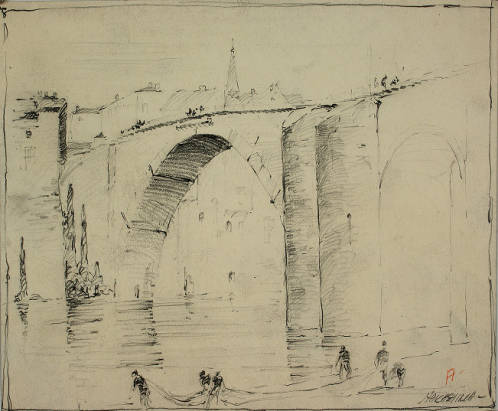
Freehand sketch: graphite on paper.
bridge ca. 1925-29.

Freehand sketch: graphite on paper.
Digital Collection item #ARC0879; URL: http://content.lib.washington.edu/u?/ac,1841
George Katsutoshi Nakashima (1905-1990) enrolled in the University of Washington program in architecture, graduating with a Bachelor of Architecture (B.Arch) about 1929. In 1931, after earning a Master's degree in architecture from M.I.T., Nakashima sold his car and purchased a round-the-world tramp steamship ticket.
While in Japan, Nakashima went to work for Antonin Raymond, an American architect who had collaborated with Frank Lloyd Wright on the Imperial Hotel. While working for Raymond, Nakashima toured Japan extensively, studying the subtleties of Japanese architecture and design. In 1937, Raymond's company was commissioned to build a dormitory at an ashram in Pondicherry, India for which Nakashima was the primary construction consultant. It was here that Nakashima made his first furniture.
In 1940, Nakashima returned to America and began to teach woodworking and to make furniture in Seattle. Like others of Japanese ancestry, he was interned during the Second World War and sent to Camp Minidoka in Hunt, Idaho, in 1942. At the camp he met Gentaro Hikogawa, under whose tutelage Nakashima learned to master traditional Japanese hand tools and joinery techniques.
In 1943, Antonin Raymond successfully sponsored Nakashima’s release from the camp and invited him to his farm in New Hope, Pennsylvania. In his studio and workshop at New Hope, Nakashima explored the organic expressiveness of wood. His signature woodworking design was his large-scale tables made of large wood slabs with smooth tops but unfinished natural edges, consisting of multiple slabs connected with butterfly joints. Drawing on Japanese designs and shop practices, as well as on American and International Modern styles, Nakashima created a body of work representing the best of 20th century American Art furniture.